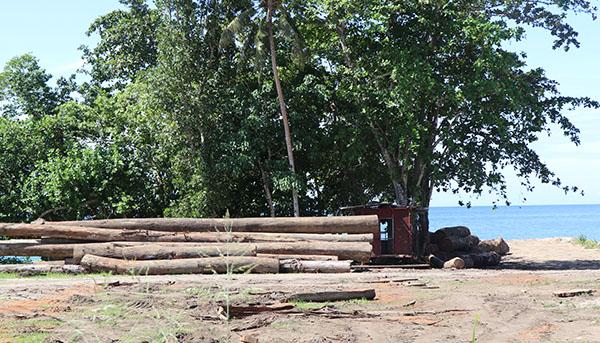
The Environment and Conservation Division (ECD) of the Ministry of Environment, Climate Change, Disaster Management and Meteorology is developing the 2019 State of Environment (SoE) Report. Once endorsed, this report will be available on the Solomon Islands Environment Data Portal (https://solomonislands-data.sprep.org/
As indicated in this Solomon Islands State of Environment report, forest harvest rates are a concern for the environment and long-term sustainability of the forestry sector.
Forestry is a major contributor to the Solomon Islands economy, accounting for approximately 10% of GDP, however forest harvested through logging and timber exports is of particular concern. After 2000 annual harvests had reached more than 1,000,000 m3 per year, whilst sustainable forest yields of 200,000 m3 were set in 1995 (Forest and Land Use Change (2000-2006) in Solomon Islands), approximately 5 times more than sustainable rates.
The loss of harvestable forests will significantly affect national revenue in the long-term given the importance of the forestry sector to the economy of Solomon Islands. Increased timber removals also mean less capacity for sequestration of CO2 emissions, loss of biodiversity, sedimentation of rivers and marine and deteriorating water catchments.
Annual area harvested has increased from 5,000 ha in 2006 to almost 20,000 ha in 2017:
The Ministry of Forestry & Research is putting in place policies and strategies for the sustainable use of forestry resources specifically to promote downstream processing and timber industry, encourage replanting and reforestation schemes, protecting endangered plant species through establishing botanical gardens and herbariums, and encouraging forestry plantations with resource owners and landholders.
Recommended actions include strengthening forestry legislation and closing existing loopholes to ensure logging companies are held responsible for re-forestation, site remediation and environmental monitoring, logging licenses should not be extended without a new permit, and full assessment of environmental impacts undertaken. A key step is to strengthen monitoring and enforcement of the Forestry Act, and implement the NBSAP target of 10% terrestrial protected area by 2020.
The Life on Land SDG 15 is focussed on the protection of forests and terrestrial ecosystems. Specifically, SDG 15.1.1 and 15.2.1 on sustainable forest management and forest area as proportion of land area.
This trend in protected habitats also directly contributes to the Convention on Biological Biodiversity (CBD) Aichi Target 5 - by 2020, the rate of loss of all natural habitats, including forests, is at least halved and where feasible brought close to zero, and degradation and fragmentation is significantly reduced https://www.cbd.int/sp/targets/#GoalB
The forestry sector is recognised in the Solomon Islands National Development Strategy 2026 – 2023 https://solomonislands-data.sprep.org/dataset/national-development-stra… as a significant contributor of export earnings through round log exports from logging of natural forest. However, the resource is not sustainable at current extraction rates and value addition is minimal. Solomon Islands’ National Biodiversity Strategies and Action Plans (NBSAP), aligned to the NDS is currently implementing a target of 10% terrestrial protected area by 2020 (https://www.cbd.int/nbsap/about/latest/default.shtml#sb). This is one method helping to address sustainable logging, the other is to reduce logging to sustainable levels.
The Solomon Islands have established a national data portal (https://solomonislands-data.sprep.org/) to store and share environmental data, with reports and datasets useful in the tracking of environmental indicators, and in the preparation of national and international reports.
The regional Inform project https://www.sprep.org/inform has established national environment data portals in 14 Pacific island countries to help address the challenge of accessing data and a place to store it. The online database of information and datasets will help improve decision-making and reporting on the environment. Visit the regional data portal in the link: https://pacific-data.sprep.org.